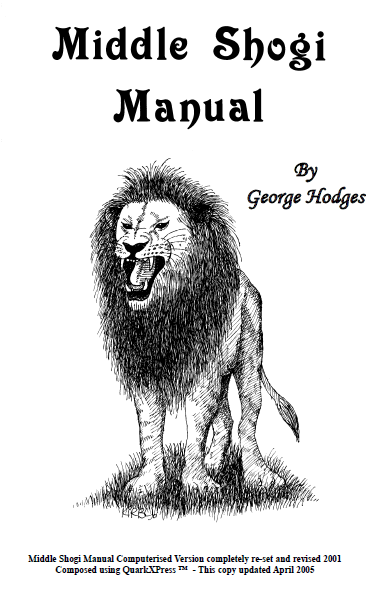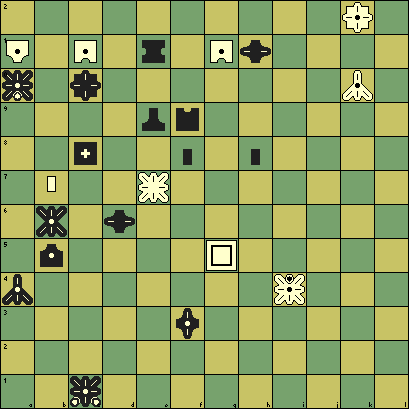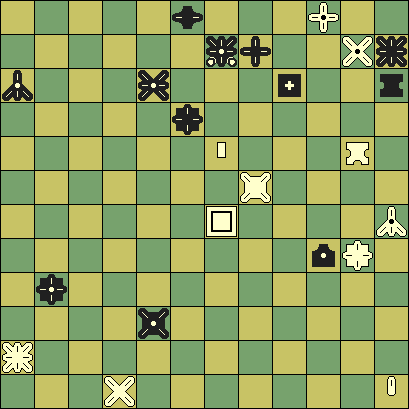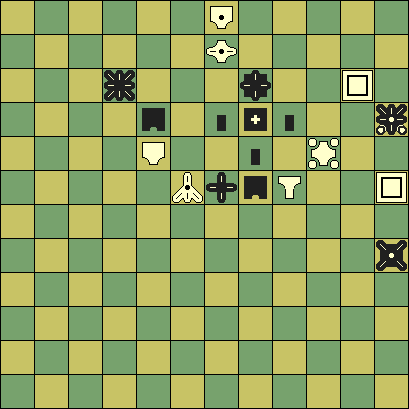
|
The Middle Shogi Manual was compiled by the late George Hodges
from historic Japanese material on Chu Shogi, and contains
224 mating problems from the Edo period.
It is still for sale, in printed form or on CD-ROM, from:
george.hodges@talk21.com
This website lists some new insights into these problems
and their solutions, obtained through analysis with the
Chu-Sogi computer program 'HaChu'.
|
Mating problems, C1-C50
Errata to the Middle Shogi Manual
All problems were fed to the HaChu engine.
This was running in tsume mode with the 'Allow repeats' setting,
which puts the obligation to deviate always on the checking side.
For problems where promotion played a crucial role,
solution was attempted with both 'Promote on entry' switched off
(which means that HaChu plays according to the rule that a piece that deferred promotion
can promote on later moves that touch the zone,
but not on the turn immediately following their deferral,
unless they capture),
as well as on
(which means non-captures can only promote when the enter the zone from without).
Note that both of these rules are different from what the Middle Shogi Manual states,
where the condition is that the next move with that piece cannot be a promotion.
The problems of the C series came without historic solutions,
and the solutions presented in the MSM were found in recent times.
Many problems so far defied solution, however.
As the HaChu analysis shows,
this sometimes is because the problems are flawed,
so that no solution exists under the rules as we know them
(or, in case of promotions, were assumed in the MSM).
In many other cases HaChu did manage to find a solution, though.
First we discuss these hitherto unsolved problems.
The unsolved problems of the C series
C8 - Impossible
C11 - The solution found by HaChu relies on the ability to promote the FL
on leaving the zone with a non-capture:
1. FLx7d= K-9d 2. Ln-7c K-10c 3. FL-8e+ K-10d 4. Ln-9e +RCx9e 5. Ph-8f mate
Under more restrictive promotion rules
(zone-entry only, or after another move with the same piece, as the MSM assumes)
no solution exists.
This could be taken as evidence against the promote-on-entry rule.
As we will see later, this is really a minority vote, though.
Also unsatisfactory is that the solution does not require the presence of the SE
(still mate in 5),
or alternatively the Ph (mate in 8).
It thus seems the design is flawed,
and we conjecture that the solution the designer had in mind is
the one the MSM mentions in the preface to the C problems:
1. +DK-8e Gx8e {lures a piece to 8e to allow the FL to promote there} 2. FL-7d= K-9d 3. Ln-7c K-10c 4. FLx8e+ K-10d 5. Ln-9e +RCx9e 6. Ph-8f mate,
which does use all pieces in an elegant way.
That 1... BT-8d refutes this line must have been an oversight of the designer.
Note that replacing the Gold at 7e by a Copper would thwart this defense, as the latter would not protect the Tiger when that arrives on d8.
This could be considered a repair, removing the need to promote on leaving the zone as well as the presence of redundant pieces.
C14 - A mate in 12 was found for this problem:

1. +RC-10k +DKx10k (1... +VM-10h 2. +DH-5j K-9d 3. FKx8d DEx8d 4.Ln-8f K-8c 5. +DH-3h SM-4g 6. +DHx4g P-5f 7. +DHx5f DE-7d 8. +DHx7d mate) 2. +DH-6i K-9d (2... SM-8g 3. +DHx8g K-9d 4. FK-9g +DH-9f 5. FKx9f K-8c 6. +DH-4c DE-6c 7. +DHx6c FL-7c 8. +GBx7c mate or 2... +S-7h 3. Lnx7h-6g K-9d 4. FKx9g +VM-9e 5. Ln-8f K-8c 6. +R-2c SM-5c 7. +Rx5c DE-6c 8. +Rx6c FL-7c 9. +GBx7c mate) 3. +DH-6g K-10e (3... SMx6g 4. FK-9g SMx9g 5. Ln-8f K-8c 6. +GB-9b DKx9b 7. +R-2c SM-5c 8. +Rx5c DE-6c 9. +Rx6c FL-7c 10. +Rx7c mate or 3... +DHx6g 4. FK-10c DKx10c 5. Ln-8f K-10c 6. +GB-9c K-11d 7. Lnx9g-9f K-11c 8. +Px12c +Lx12c 9. +R-11a +DK-11b 10. +GB-10b DKx10b 11. Ln-11e mate) 4. +DH-8g SMx8g 5. Lnx8g K-9d 6. FK-7f Px7f 7. Ln-8f K- 8c 8. +GB-9b DHx9b 9. +R-2c SM-5c 10. +Rx5c DE-6c 11. +Rx6c FL-7c 12. +Rx7c mate
C21 - There only is a solution if the FL is allowed to promote with a non-capture out of the zone.
1. DH-7d+ K-8b 2. +DHx!7c K-9c 3. FK-6f K-7b 4. FL-5e+ +L-6d 5. +FLx6d R-7c 6. +DHx!6d +DK-6d 7. +DH-9b mate
C22 - This is a mate in 17:

1. FK-1l +SMx1l (1... DH-1e 2. FKx1e +VMx1e 3. +DK-1d R-1c 4. +DK8d-3d K-2b 5. +DK1d-2e R-2c 6. +DK3dx2c mate or 1... R-1c 2. +DK-3d +VMx3d 3. +DKx3d K-2b 4. +VM-5e Gx5e 5. +DK-4d K-1b 6. FK-6g G-5f 7. FKx5f R-3c 8. +DK-3d K-1c 9. +DKx3c mate or 1... K-2c 2. +DKx4c +VM-3c 3. +DKx2e K-3b 4. FK-7g FL-5d 5. +DH8dx5d K-4a 6. +DK2ex4e +VM-4b 7. +DK-2c mate) 2. +VM-1f DKx1f 3. DK-3d K-2b 4. +DK-3c +VMx3c 5. +DK-2d K-3b 6. +DKx3c-4b Kx4b 7. Ky-2d+ K-5c 8. Ln-3d K-6d 9. Lnx4c K-7-c 10. Ln-6e and Lion mate follows
C23 - No solution exists under the known rules.
C25 - Mate in 12:

1. +DH-11b Kx11b 2. +DK-10d K-10a 3. +SMx6e K-9a 4. +SM-2a K-8b 5. +SM-3b +B-4b 6. +SMx4b K-9a 7. +SM-6d K-10a 8. L-12c+ K-9b 9. +DK-7b Ky-8b 10. +DK-7d K-9a 11. +SM-3a Ky-7a 12. +SMx7a mate
When repeats are strictly forbidden,
gote can be 'smoked out' four moves faster,
because after 4. +SM-5e K-9b 5. +SM-6e
stepping back to 9a is no longer an option as it creates a repeat,
so that the King is forced to the fatal 8th file imediately.
C26 and C27 - No tsume exists under the known rules
C31 - When the Silver is allowed to promote on stepping out of the zone,
a mate in 9 can be achieved:

1. P-6d+ +Lx12k 2. DK-3d+ FKx3d 3. Sx3d= K-4b 4. DK-2d+ +Bx2d 5. S-4e+ +SM-4c 6. +Sx4c Kx4c 7. Ln-4e K-4b 8. B-3c Kx3a 9. Ln-4c mate
This mate would also work if we delete sente's Lance, Bishop and Whale, however,
and is thus unlikely to be what the designer intended.
A much more difficult mate, which does use all pieces,
is necessary under 'promote on entry' rule:
1. P-6d+ +Lx12k 2. B-11j +Rx11j 3. DK-3d+ FKx3d 4. Ln-4e {to lure the FK to 4e, so the silver could promote there on leaving the zone} FKx4e 5. S-3d= FKx3d (5... K-4b 6. Sx4e+ +DK-4d 7. +Sx4d +SM-3d 8. +Sx3d K-3d 9. DK-2c+ K-4b 10. DK-4e mate) 6. DK-2c+ K-4b 7. +RC-4j +P-4i 8. +RCx4i +DK-4d 9. +RCx4d +SM-4c 10. +FL-3c Kx3a 11. L-1c+ +Bx1c 12. +DKx1c K-2a 13. +DK-1a K-3b 14. +DK-2b K-3a 15. +DK-2a mate
C33 - Mate in 16:

1. +SM-12b K-10a 2. FL-7d+ Rx7d 3. +SM-11b K-9c (3... K-11a 4. +SM-12a Kx12a 5. +DH-9d FLx9d 6. FLx9d+ K-11a 7. +P-11b mate) 4. +SM-10c Kx10c 5. FL-10d+ Kx10d (5... K-9b 6. FL-10c Kx10c 7. Ln-9e K-9b 8. Lnx10e-9d K-10a Ln-11b mate or 5... FLx10d 6. +DH-10e FLx10e 7. Ln-9e and Lion mate follows) 6. +DHx10e Kx10e 7. Ln-9g K-9d 8. Lnx11f K-8e 9. Ln-9g K-9d 10. Ln-9f K-8c 11. Ln-9e K-9b 12. Lnx8dx7d K-8a 13. Ln-6c K-9b 14. Ln-7a K-10a 15. Lnx8b-8a K-11a 16. Ln8a-10c mate
Note that it would be trivial to force gote to make the first repetition here,
by delivering a perpetual (1. +DHx9a Bx9h 2. +SM-12a K-10a 3. +SM-11a K-11a {repeat}).
So that when repeats are strictly forbidden,
3. +SM-11a would be a checkmate.
Apparently the burden to deviate is on the checker.
C36 - A straightforward mate in 9:

1. +DK8h-6f +DHx6f (1... K-7c 2. +DKx5e Cx5e 3. +DKx5e K-8d 4. Ln-10f K-9c 5. Ln-11d K-8d 6. Ln-9e mate or 1... K-9c 2. +DK-9i K-10c 3. +P-10d Kx10d 4. Ln-10f K-11c 5. FK-11h K-10c 6. Ln-10e mate) 2. Ln-9f +DHx9f 3. +DK-6f +DHx6f (3... K-9c 4. +DKx9f K-10c 5. +DK-11d K-9c 6. FK-9l +P-9h 7. FKx9h DE-9d 8. FKx9d mate) 4. FK-12h +DH-10f 5. FKx10f K-9c 6. FK-9e K-10c 7. +P-10d K-11b 8. +P-11c K-12a 9. +P-12b mate
C37 - Again the promotion rule is crucial.
When in-zone promotion is allowed (with a one-turn delay),
there is a mate in 7:

1. Phx5c= K-6e 2. +RC-7d BTx7d 3. Gx7e {protected by the Phoenix!} FKx7e 4. Ph-4c+ +B-5d 5. +Phx5d Kx5d 6. +Ky-4c Kx4c 7. Ln-3e mate
Note that either the Lion on 2c or on 1f (and then the +P on 6a with it) are redundant in this case, although their absence would lengthen the mate to 11 moves.
When promotion is only allowed on zone entry or capture, however,
a mate in 12 results where each piece has significance:
1.. +Ky-4c {lures a piece to 4c so the Ph can promote there} DKx4c 2. Phx5c= K-6e 3. +RC-7d BTx7d 4. +G-7e FKx7e 5. Phx4c+ +B-5d 6. +Phx5d Kx5d 7. Ln-3e K-6e 8. Ln-5g K-5d 9. Lnx7e K-4c 10. Lnx7d-6c K-3d 11. Ln-5c K-2c 12. Ln-3b mate
C40 - A straightforward mate in 11 with a hopping Falcon:

1. +DH-4i +Px4i 2. Ln-5j +Px5j 3. +DH-4i K-5g 4. +DH-4g K-6f 5. +DHx6e K-5g 6. +DH-4g K-6f 7. +DH-5f K-7e 8. +P-6e Kx8e 9. +DH-9f K-8d 10. +DH-9d K-7c 11. +DH-6d mate
C41 - This problem has a mate-in-7 solution of which one can wonder if it is the one intended by the composer,
as many of the pieces remain unused:
1. +SM-7h K-9g 2. +DKx4g BT-8g 3. +DKx8f Gx8g 4. FK-9e FL-9f 5. FKx11g K-8f 6. +SMx6h K-7f 7. DH-6g mate
C42 - No solution exists under the known rules.
C45 - A wonderful mate-in 14,
based on clearing the path for the FK to 8b,
and a defense to it that promotes the DE to Crown Prince,
so that you have to start all over again hunting that.

1. DH-9l +G8kx9l {must stay out of Lion reach} (1... K-7k 2. DKx8k K-6l 3. FKx6g C-6h 4. FKx6h K-5l 5. FK-2l +RC-4l 6. FKx4l mate) 2. Ln-10j +Gx10j 3. +SM-1e DEx1e {this offers higher reward than chasing with the +BT. Interpositions are futile, as all squares on the path are once protected, and twice attacked if you allow the checker to survive. E.g.} (3... S-3g 4. +Bx3g +L-4h 5. +Bx4h Cx4h 6. +SMx4h P-5i+ 7. +SMx5i +DK-6j 8. +SMx6j K-7l 9. DH-7k mate) 4. +L-2f DEx2f 5. +B-3g DEx3g 6. +VM-4h DEx4h 7. FK-8b +DK-8i 8. FKx8i DE-5i+ 9. FKx8l +DE-6h 10. DK-6k +DE-7g 11. FKx10j +DE-7f (11... S-8h 12. FK-10g +DE-7f 13. DK-6g +DE-8f 14. DK-6f mate) 12. FK-6f +DE-8g 13. DK-6g +DE-9h 14. DKx9g mate
C46 - This is a mate in 11 (8 when discounting futile interpositions of +BT, C and +DH).
The crux is to get the DH on the 8a-1h diagonal with checking moves.

1. Ln-5j +Px5j 2. +SM-4k +Px4k 3. DK-7j +L-5j (or 3... +BT-6j with same continuation, or 3... FKx7j 4. C-2k K-2i 5. DH-2d+ Cx2d 6. +DH-2f K-1h 7. Lx1b+ +DH-1d 8. +Lx1d C-1e 9. +Lx1e mate) 4. C-2k K-2i 5. DH-2d+ Cx2d 6. +DH-2f K-1h 7. DK-7b+ +BT-6c 8. +DKx6c FK-4e 9. Lx1b+ C-1e 10. +Lx1e +DH-1g 11. +DKx4e mate
C50 - No solution exists under the known rules.
Comments on the MSM solutions
C3 - Faster (mate in 13 in stead of 16) is:
3. FLx10k +GBx10k 4. +DH-12l K-9k (4... K-9j 5. +DH-12j K-9k 6. FK-6k K-9l 7. FK-6l +R-8l 8. +DH-7j K-10l 9. FKx8l +GB-9l 10. FKx9l K-11k 11. +DH-11j mate) 5. FK-6k +R-8k 6. +RC-5g K-9j 7. +DH-12j +BT-10j 8. FK-5j K-8i 9. +DH-12i +BT-11i 10. +DHx11i K-9h 11. FK-7h +R-8h 12. +DH-8i K-9g 13. +DHx8h-8g mate
C6 - This problem is flawed.
The solution according to the MSM can be refuted through
5... Ln-6d 6. +Lx5d K-5b,
and there is no alternative line.
With a B in stead of a +FL on 2a, however, there is a mate in 7:
1. +DH-6f Lnx6f 2. +Phx6f K-5c 3. Bx5d+ Kx5d 4. Ln-4f K-5c 5. +L-5i K-4b 6. Ln-5d K-4a 7. Lnx3c mate.
This does not make essential use of the Rook on 12e, however,
although in its absence the mate takes two moves longer.
So it is questionable whether a +FL-for-B copying error is the culprit.
C9 - Faster (mate in 7 in stead of 9) is:
2. FK-10e +RCx10e (2... K-12e 3. FK-12g BTx12g 4. +DHx12g K-11d 5. +DK-x9f mate) 3. +DK-9f K-12e 4. +DK-12f BTx12f 5. +DH-12g K-11d 6. +SM-12c Kx12c 7. +DHx12f-12e mate
C17 - After 8... K-2f 9. FK-2h is mate, and the best defense is 8... K-2e
C19 - Last move must be 5. +Lx6b, as after 5. +Bx6b gote still has 5... K-6a
C29 - After 2... K-4d it is mate in 4:
3. C-3d+ +DK-4d 4. +Cx4d mate
so 2... Kx3c is best defense.
C30 - After 6... K-9c in the main line of the MSM solution
7. +G-4c K-9b 8. FK-8c mate is faster.
Best defense is 6... K-7b 7. +G-4b (7. FK-2b R-3b {not entirely futile, as it mis-positions the FK for a fast mate} 8. FKx3b K-6c 9. FK-3c K-5d 10. FK-4c K-5e 11. FK-4e mate) K-6c 8. FK-8c K-5d 9. FK-4c K-5e 10. FK-6e mate
C32 - The presence of the Lion is essential here,
as otherwise 2... FK-2b would refute the mate.
The +RC on 7h seems to be redundant, however.
C34 - There seems to be a simple mate in 2 here,
through 1. Ln-3f???
C35 - HaChu can improve the MSM solution to a mate in 11,
by disposing of its DH at an earlier opportunity to move it away with check:
1. SM-9d+ Kx9d (2... K-9c 3. +SM-10d K-10b 4. +SM-12b K-9a 5. +SM-11a K-8b 6. +RCx8e mate) 2. +VMx8e K-9e 3. +VM-8f K-9f 4. +VM-8g K-9g 5. DH-4l +Rx4l (5... Lnx4l 6. +VM-8h K-9h 7. +VM-8i K-9i 8. C-8j +DHx8j 9. +VMx8j K-9j 10. +RC-8l mate) 6. +VM-8h K-9h 7. +VM-8i K-9i 8. C-8j +DHx8j 9. +VMx8j K-9j 10. VMx1b+ +BT-3c 11. +VMx3c mate
C48 - In the MSM solution 11. +SM-9a is not possible
because of 11... DHx9a.
The correct continuation is:
11. Ph-11d+ DHx11d 12. +SM-9a K-9b 13. FM-8b K-10c 14. FK-11b Kx11b 15. +S-11c DHx11c 16. RC-12a+ mate
C49 - The status of 'jewel in the crown' of this problem might be jeopardized
by the fact that HaChu finds a mate in 11,
not using most of the pieces:
1. Bx10f +DHx10f (1... +FLx10f 2. DH-10h K-11f 3. FK-11l +DHx11l 4. DKx11l Kx10e 5. DKx11d+ K-9e 6. +SM-8d K-8e 7. +GBx7f mate) 2. DH-10h +DHx10h (2... K-11f 3. FK-11l +DHx11l 4. DKx11l +DH-11g 5. +P-10f +FLx10f 6. DH-9d+ VM-10e 7. +DHx11d K-12g 8. DKx12l +DH-12h 9. +DHx10e mate) 3. FK-11l K-12g (3... +DHx11l 4. DKx11l +DH-11h 5. +SM-9g K-11f 6. DKx11h Kx12e 7. DH-12a+ +FL-12b 8. +DHx12b mate) 4. +P-12f +DHx12f 5. +SM-9g +FL-10g 6. FKx10g +DHx10g 7. DHx12l K-11f 8. +P-10f VMx10f 9. DH-9d+ K-11e 10. +DH-8e K-10d 11. DK-12b+ mate
Conclusions
Of the 18 problems of the C series that were unsolved in the MSM,
HaChu could prove that six have no solution under the known rules.
Ten others could be solved,
but for one of those the solution seems to be a 'parasitic' one not intended by the composer.
For the remaining two problems it depends on the exact promotion rule.
Both of those can be solved under the rule where any non-capture that touches the zone
(i.e. ends and/or starts inside it)
can be a promotion,
after a one-turn delay since the deferral.
In both these cases the solution does not look like the intended one, however,
as some of the attacker's pieces can be deleted without affecting the solution.
When non-captures can only promote on entering the zone, however,
these problems are proven unsolvable.
One of them has a line that looks like the intended solution
(by criteria of making essential use of all pieces, as well as elegance),
but the line is flawed, as better defense is possible.
For the other no such likely intended solution has been identified.
Of the problems 'solved' in the MSM,
one problem was found to be flawed.










